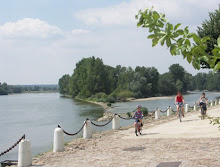But there is an even older history of underground living here and one of the most impressive places to see this is the Chateau de Brezé. A short distance from Saumur, whilst the visible chateau was built in the 1300's, the earliest record of a 'chateau' here dates back to 1063. But to see where the noblemen of this time lived, you have to go down...up to 20 metres below the current ground level.
Back in the 'dark days' the land was often invaded and so those with enough money, power and peasants (to do the work!) dug out a fortified underground home for their family. Adults, children, and even livestock used to live underground at times of peril and leave those less fortunate to the mercy of the marauding hordes. You can see niches carved into the stone for chicken roosts, holes used to tie up cattle and horses, and great carved out columns for chimneys and air holes.
This underground village was also tremendously well fortified - with portcullis, narrow winding passages (impossible for attackers to carry spears) and false entrances.
In the 14th century the above-ground chateau was fortified and the dry moat constructed. In places this is 20 metres deep and is the deepest in Europe and really very impressive; you can see how impenterable the chateau was.
Impressive though the moat itself is, there are more surprises hidden in its inner walls. During your visit you can see grain stores, silkworm caves, stables and a wonderful 2 storey boulangerie - complete with what must have been a very cosy baker's bed right above the bread oven! The chateau also owns vineyards and you can see the extensive wine caves (and old stone wine presses) before tasting the produce in the (above ground) stable buildings in the grounds.
A visit to this unique chateau is included on our Discovery and Wine tours and we are working on a cycle route there too.





